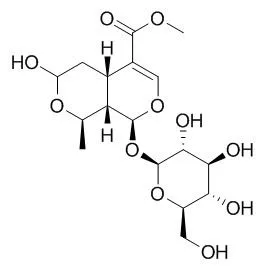| Kinase Assay: |
| J Pharmacol Sci. 2015 Apr;127(4):414-8. | | Induction of CYP3A by morroniside in rats.[Pubmed: 25953268] | Morroniside is one of the most important iridoid glycosides in the herbal drug Cornus officinalis Sieb. et Zucc.
METHODS AND RESULTS:
The current study was designed to investigate the ex vivo and in vivo effects of Morroniside on CYP3A activity in rats after treatment with Morroniside for 7 days (at 10, 30, 90 mg/kg, i.g.). Morroniside was found to induce CYP3A. According to the ex vivo experiment, the activity of CYP3A was measured by the quantification of 1-hydroxymidazolam, which was the metabolite from CYP3A probe substrate, midazolam. The concentration of 1-hydroxymidazolam was determined by using a validated liquid chromatography coupled with tandem mass spectrometry detection (LC-MS/MS) method. The levels of messenger RNA (mRNA) and protein of CYP3A were determined by reverse transcriptase-polymerase chain reaction (RT-PCR) and western blotting analysis, respectively. The pharmacokinetics of midazolam in rats after treatment with Morroniside for 7 days (at 10, 30, 90 mg/kg, i.g.) were investigated in vivo. After treatment with Morroniside, the activity, mRNA and protein expression of CYP3A were significantly induced and the absorbance and bioavailability of midazolam in rats were reduced.
CONCLUSIONS:
The results indicated that Morroniside could induce the activity of CYP3A. |
|
| Animal Research: |
| PLoS One. 2014 Jun 30;9(6):e101194. | | Morroniside improves microvascular functional integrity of the neurovascular unit after cerebral ischemia.[Pubmed: 24979385] | Treating the vascular elements within the neurovascular unit is essential for protecting and repairing the brain after stroke. Acute injury on endothelial systems results in the disruption of blood-brain barrier (BBB), while post-ischemic angiogenesis plays an important role in delayed functional recovery.
Here, we considered alterations in microvessel integrity to be targets for brain recovery, and tested the natural compound Morroniside as a therapeutic approach to restore the vascular elements of injured tissue in a rat model of focal cerebral ischemia.
METHODS AND RESULTS:
Sprague-Dawley rats were subjected to middle cerebral artery occlusion (MCAO) model, and Morroniside was then administered intragastrically once a day at doses of 30, 90, and 270 mg/kg. BBB integrity and associated factors were analyzed to identify cerebrovascular permeability 3 days after MCAO. The recruitment of endothelial progenitor cells (EPCs), the expression of angiogenic factors and the new vessel formation in the peri-infarct cortex of rats were examined 7 days after MCAO to identify the angiogenesis. We demonstrated that at 3 days post-ischemia, Morroniside preserved neurovascular unit function by ameliorating BBB injury. By 7 days post-ischemia, Morroniside amplified angiogenesis, in part by enhancing endothelial progenitor cell proliferation and expression of angiogenic factors. Morever, the increase in the amount of vWF+ vessels induced by ischemia could be extended to 28 days after administration of Morroniside, indicating the crucial role of Morroniside in angiogenesis during the chronic phase.
CONCLUSIONS:
Taken together, our findings suggested that Morroniside might offer a novel therapeutic approach for promoting microvascular integrity recovery and provide a thoroughly new direction for stroke therapy. | | Mol Med Rep. 2013 May;7(5):1565-70. | | Morroniside promotes bone marrow mesenchymal stem cell proliferation in rats.[Pubmed: 23546017] | The aim of this study was to explore the mechanism underlying the promotive effect of Morroniside on rat mesenchymal stem cell (RMSC) proliferation and to provide an experimental basis for the development of potential new drugs.
METHODS AND RESULTS:
RMSCs were obtained from the bone marrow of Sprague-Dawley rats aged 3-4 months. The proliferation of primary and subcultured RMSCs in the high‑, medium‑ and low‑concentration Morroniside intervention and blank control groups was observed using light microscopy. Cell proliferation and survival conditions were detected using methyl thiazolyl tetrazolium (MTT) colorimetric tests. Light microscopy and the MTT assay revealed that RMSC adherence time in the Morroniside groups was shorter compared with that of the control group. Twelve hours after the media of primary RMSCs were changed, the number of adherent cells in the Morroniside groups increased and an elongated cell morphology was observed. The cells at the fourth passage in the Morroniside groups fused completely 12‑16 h after inoculation and then rapidly entered into the logarithmic phase. The primary RMSCs of the Morroniside intervention groups grew into typical bone marrow mesenchymal stem cell (BMSC) colonies after 4 days of Morroniside treatment and their fusion rate had reached 80% after 9‑11 days. By contrast, the cell fusion rate of the control group only reached 75-80% after 14 days of Morroniside treatment.
CONCLUSIONS:
Morroniside exhibited a similar promotive effect on proliferation in primary and subcultured RMSCs.
Morroniside may promote RMSC proliferation through secreted factors, cell-to-cell interactions and/or the interactions between cellular adhesion molecules and extracellular matrices (ECMs). However, the specific mechanism underlying this effect remains to be fully elucidated. | | Chinese Journal of Rehabilitation Theory & Practice, 2012, 18(4):331-2. | | Effects of Morroniside on Cycloxygenase after Platelet Aggregation Induced by Adenosine Diphosphate in Rabbits.[Reference: WebLink] | To investigate the effect of Morroniside on cycloxygenase(Cox) in the condition of platelet aggregation induced by adenosine diphosphate(ADP) in rabbits.
METHODS AND RESULTS:
The levels of Cox induced by ADP in different groups were detected by enzyme-linked immunosorbent assay(ELISA). Compared with the control group,all the Morroniside groups significantly inhibited the increase of Cox induced by ADP(P0.001),which had concentration dependence,and the inhibition rate of high dose group was 30%.
CONCLUSIONS:
Morroniside can decrease the level of Cox and it may be the mechanism of Morroniside on inhibiting the platelet aggregation induced by ADP in rabbits. |
|






 Cell. 2018 Jan 11;172(1-2):249-261.e12. doi: 10.1016/j.cell.2017.12.019.IF=36.216(2019)
Cell. 2018 Jan 11;172(1-2):249-261.e12. doi: 10.1016/j.cell.2017.12.019.IF=36.216(2019) Cell Metab. 2020 Mar 3;31(3):534-548.e5. doi: 10.1016/j.cmet.2020.01.002.IF=22.415(2019)
Cell Metab. 2020 Mar 3;31(3):534-548.e5. doi: 10.1016/j.cmet.2020.01.002.IF=22.415(2019) Mol Cell. 2017 Nov 16;68(4):673-685.e6. doi: 10.1016/j.molcel.2017.10.022.IF=14.548(2019)
Mol Cell. 2017 Nov 16;68(4):673-685.e6. doi: 10.1016/j.molcel.2017.10.022.IF=14.548(2019)